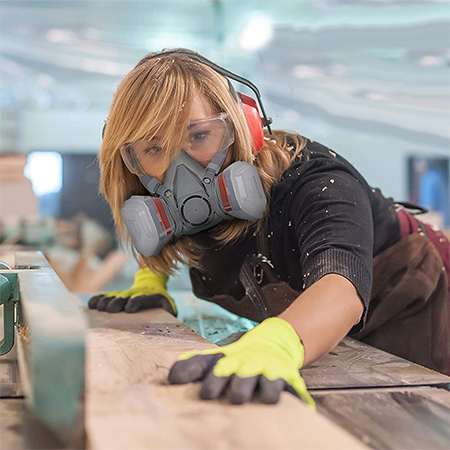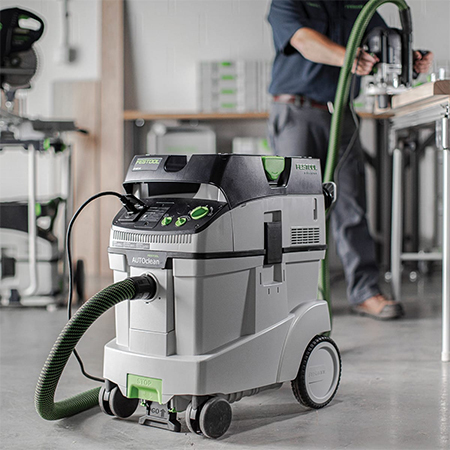Safety Tips when Using Power Tools that Spin at High Speed
Are power tools dangerous? Yes, but only if you use them incorrectly or do not take the proper safety precautions.
06/06/2023
I recently attended an exhibition that revolved around most of the major power tool brands currently available in South Africa. Suppliers and distributors put on regular demonstrations to show how different power tools worked and could be used to increase productivity without sacrificing quality and, in fact, many of the tools on display would effectively bring a more professional finish to tasks.
During one of the demonstrations, the demonstrator was using a high-speed edge trimmer (no brand names) to show the audience how effectively the tool tackles the project, but following safety guidelines and wearing a pair of gloves, the gloves became entangled with the spinning cutter and snagged the glove and a finger. The edge trimmer resembles a router in that it spins at high speed and, as with all power tools that spin, you sometimes have to overlook certain recommended guidelines to ensure user safety.
Safety rules advise that PPE gear be worn at all times when working with power tools and particularly high-speed power tools. The reasons for this are obvious and are intended to protect the user from harm. Unfortunately, sometimes those protection methods can hinder and harm the user. As a PSA, take note of the following guidelines but also apply some common sense when doing specific tasks:
The most important reason for wearing safety glasses is to protect your eyes. Protective eyewear such as safety glasses prevents most eye injuries and should be worn at all times, at work or at home, where eye safety is an issue. The majority of eye-related injuries are preventable by donning safety glasses.
Safety glasses are specifically designed for eye protection when using tools and materials that could cause severe injury or blindness.
# Safety Glasses
Safety glasses are recommended when doing any task with power tools that results in any type of fragment or dust being released during operation. That sounds about right, as long as you wear safety glasses that are not badly scratched or fog up while you are working. Make sure that safety glasses are scratch-free, cleaned properly, and have gaps that allow sufficient air circulation to prevent fogging up.
Select PPE eyewear that has a high safety rating and is manufactured using impact-resistant polycarbonate lenses.
Take extra precautions when using the tool so that the item you are working on will not spread debris in your direction. Note the direction of the cutting blade and stand well away and to the other side to protect yourself from harm.
# Heavy-Duty Gloves
Gloves are intended to prevent any harm to your hands and provide a level of protection required when working with materials with sharp edges or flying shrapnel such as tiles, glass, concrete or stone, or metals. Even when working with timber and board, gloves will protect hands from sharp edges and splinters.
However, gloves can sometimes be a hindrance when using power tools that need to be guided around a specific task such as trimming edges or cutting angles in materials such as ceramics, stone, and metals. Sometimes gloves need to be removed to allow for manual manipulation and this is when you need to be aware of the danger and keep your hands well away from any moving or spinning parts. The only other solution to this is to invest in PPE gloves that are designed for specific jobs.
Fabric and cotton gloves are okay for protection against dust and fairly routine tasks such as gardening but offer minimal protection. Fabric gloves with a nitrile coating are preferred for anyone handling or working with materials that have sharp edges and are the preferred protection for DIY enthusiasts and woodworkers. For tasks that involve the use of angle grinders, polishers, and heavy-duty tools, leather gloves provide enough protection despite the fact that they limit dexterity.
Keep these safety factors in mind when selecting gloves:
- Make sure the fit properly and do not limit dexterity.
- Prioritise safety versus dexterity when you need to be able to move or position items.
- Select a level of protection that allows you to perform a task with less risk of injury.
- Ensure gloves are not damaged prior to use.
# Dust Masks
The term dust mask is a loose one because there are all different types of dust masks, each relative to the size of dust particles produced. Power tools that cut, sand, or trim, at high speed will obviously produce finer dust than would say a jigsaw or circular saw. When you are working with spray paint or chemicals a standard dust mask is insufficient and the same applies where small particles of dust occur. In these instances, it is best to invest in a dust mask for the specific project you need to do.
The rating for dust masks determines the effectiveness of the mask against dust particles. FFP1, FFP2 and FFP3 are rated to protect against dust and the higher the rating the better the level of protection. Take note that many locally or imported board products contain harmful toxins that you need to protect yourself against and buying the cheapest rather than the most effective is not in your best interests.
For the ultimate protection when performing tasks invest in a quality dust mask that filters out the majority of particulates. A P100 or N95 mask filters out dust.
Protect yourself and your workshop environment with a Festool dust extractor. Visit festool.co.za/products/dust-extraction for more information on the total range
# Ear Protection
Most DIY enthusiasts never give thought to wearing ear protection but this PPE is just as important, if not more, than any other type of personal protection gear. If you consider the sound level of high-speed power tools, the noise can be harmful for your ears. Any form of ear protection, whether sound-blocking headphones or ear plugs should be worn when operating any noisy tools.
Mitre saw, router, angle grinder or any other power tool where the noise is hard to ignore is when you should be wearing ear protection to prevent long-term damage.












